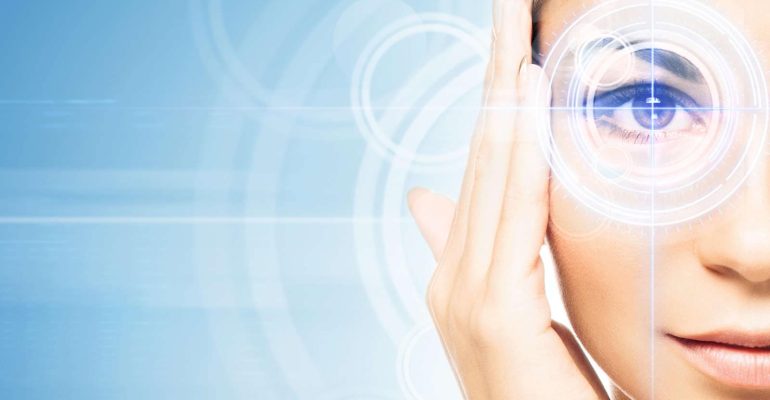How the eye works
Our eyes provide around 70% of all our sensory information with vision usually regarded as our most highly prized sense. In the area of Ophthalmology we combine medical and surgical knowledge regarding the eyes with the subject of optics and this is usually a recipe for a series of long, technical and often indecipherable words which can at best be confusing but are often incomprehensible! This section of the website aims to try to demystify some of these terms and hopefully explain the background to the procedures discussed on these pages.
Just over half of the UK population aged 40 – 69 years requires spectacles or contact lenses to see clearly with around quarter being myopic or short sighted and the frequency of hyperopia or long-sightedness increasing with age. All of us become presbyopic with age whether or not we require correcting lenses to see clearly earlier in life, so most people will require reading glasses at some stage in their life typically starting from their mid to late 40’s.
The eye works like a camera with the cornea which is the clear, transparent dome at the front of the eye providing the majority of the focussing power which is fixed. The natural lens suspended within the eyeball provides the remaining variable focussing power allowing us to change focus from far distance to close to without correcting lenses when we are young and have normal vision. That light is focussed onto the retina which lines the inside of the eyeball and this converts light into signals transmitted along the optic nerve to the brain. Here, these are decoded in the visual cortex into an image recognisable by ourselves.
Normal vision
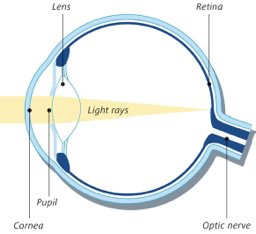
- The vision quality we enjoy is largely determined by the size and shape of our eyes.
- With normal vision, the eye’s dimensions are well-aligned.
- Light rays are focused directly on the retina to create a clear image.
- Around half of adults in the UK enjoy normal vision until the age they require reading glasses
What is Myopia (short or near-sightedness)?
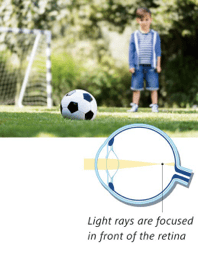
- When the eyeball is too long, the light rays are focused in front of the retina.
- Distant objects appear blurry, those up close are clear.
- Around a quarter of UK adults are short-sighted which tends to develop in the early teens
Myopia can be corrected by corrective lenses, spectacles or contact lenses, by laser eye surgery such as SMILE, LASIK or ASA and by ICL surgery. When performing cataract surgery or RLE we will also take into account myopia so that this can also be corrected at the same time as lens replacement.
What is Hyperopia (long or far-sightedness)?
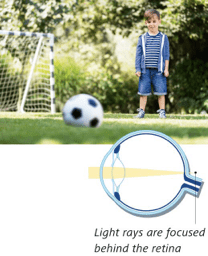
- When the eyeball is too short, the light rays are focused behind the retina.
- Nearby objects appear blurry, distant ones are clear.
- Hyperopia tends to increase in frequency with age
- Women are more likely to be hyperopic than men
Hyperopia can be corrected by corrective lenses, spectacles or contact lenses, by laser vision correction such as LASIK or ASA and by ICL surgery. Hyperopia is often accompanied by Presbyopia, the need for reading glasses or glasses for close work. PRESBYOND is a specialist laser procedure which addresses this specifically.
When performing cataract surgery or RLE we will also take into account hyperopia so that this can also be corrected at the same time as lens replacement.
What is astigmatism?
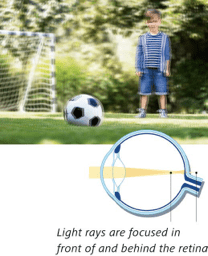
- The cornea’s irregular shape causes light rays to focus on more than one point.
- Overall vision appears blurry or distorted.
- Around 70% of adults have astigmatism of 0.5D with around 30% recorded as having astigmatism of 1.0D
Astigmatism can be corrected by corrective lenses, spectacles or contact lenses, by laser vision correction such as SMILE, LASIK or ASA and by ICL surgery. When performing any refractive procedure to improve your vision, including cataract or RLE surgery, we will take into account the degree of astigmatism present so that this can also be treated at the same time as the primary procedure.
Your prescription explained
A spectacle prescription is made up of several numbers prefixed by a plus or minus sign. Each eye will have the prescription or refraction for that eye specified in the opticians report. Here is the prescription of a person who is myopic with astigmatism.
-2.00 / -1.5 x 180
The first (+/-) sign in front of the first number refers to short or long-sightedness. As the shape of the eyeball in myopia causes the image to be focussed in front of the retina, focusing power must be subtracted to refocus the image on the retina so in this example a minus sign is present.
The first number (2.00) is the unit of optical power called a dioptre. One dioptre of optical power brings light to a point focus in one meter, two dioptres (D) in half a meter, three dioptres in 33cm. You can see that if you had an optical correction of -3.00D your natural focus would be at 33cm without glasses, this would enable you to read comfortably without glasses at any age.
The second number (1.5) refers to the amount of astigmatism. The effect of astigmatism on vision is variable but above 0.75D is thought be significant for most people. The +/- sign refers to the meridian or clock hour of the astigmatic power.
The last number which follows the multiplication sign (x 180) refers to the axis or angle of astigmatism. Most people with astigmatism will start out with a negative number followed by x 180, this is called ‘with the rule’ because it applies to the majority. A negative number followed by x 90 means that the meridian of corneal power is 90 degrees different, this is ‘against the rule’ astigmatism. A negative number followed by x 45 or x 135 refers to oblique astigmatism.
What is near ‘add’?
Your optician will measure your near vision using a standard reading type. Once presbyopia develops with loss of flexibility of the natural lens you will notice that with additional (plus) lenses you will see more comfortably. The optician will ‘add’ focussing power to your distance correction, so if the prescription above were your distance correction the new prescription might read:
-2.00 / -1.5 x 180 near +1.00
If you required an additional 1.00D of power to read comfortably.
What is Prism?
If your eyes do not align perfectly there will be an additional entry in the prescription relating to prismatic correction which will be a number followed by ∆ symbol and the orientation of the prismatic lens which will be base in (BI), base out (BU), base up (BU) or base down (BD) so the prescription might now read:
-2.00 / -1.5 x 180 near +1.00 1∆ BO
If the correction was 1 prism dioptre base out.
Medical Disclaimer
This article is for information purposes only and should not be considered medical advice. If you or any other person has a medical concern, you should consult with your health care provider or seek other professional medical treatment. Never disregard professional medical advice or delay in seeking it because of something that you have read on this blog, website or in any linked materials.


